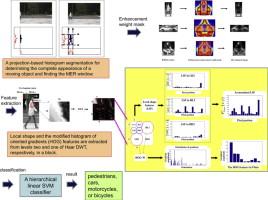Moving object classification using local shape and HOG features in wavelet-transformed space with hierarchical SVM classifiers |
| |
| Affiliation: | 1. State Key Laboratory of Structure Chemistry, Fujian Institute of Research on the Structure of Matter, Chinese Academy of Sciences, Fuzhou 350002, China;2. Graduate School of the Chinese Academy of Sciences, Beijing 100049, China;1. Intelligent Computing Group, Faculty of Computer Science and Information Technology, Universiti Putra Malaysia, 43400 UPM Serdang, Selangor, Malaysia;2. Intelligent Systems Laboratory, University of Bristol, Bristol BS8 1UB, United Kingdom |
| |
| Abstract: | 
This paper proposes an integrated system for the segmentation and classification of four moving objects, including pedestrians, cars, motorcycles, and bicycles, from their side-views in a video sequence. Based on the use of an adaptive background in the red–green–blue (RGB) color model, each moving object is segmented with its minimum enclosing rectangle (MER) window by using a histogram-based projection approach or a tracking-based approach. Additionally, a shadow removal technique is applied to the segmented objects to improve the classification performance. For the MER windows with different sizes, a window scaling operation followed by an adaptive block-shifting operation is applied to obtain a fixed feature dimension. A weight mask, which is constructed according to the frequency of occurrence of an object in each position within a square window, is proposed to enhance the distinguishing pixels in the rescaled MER window. To extract classification features, a two-level Haar wavelet transform is applied to the rescaled MER window. The local shape features and the modified histogram of oriented gradients (HOG) are extracted from the level-two and level-one sub-bands, respectively, of the wavelet-transformed space. A hierarchical linear support vector machine classification configuration is proposed to classify the four classes of objects. Six video sequences are used to test the classification performance of the proposed method. The computer processing times of the object segmentation, object tracking, and feature extraction and classification approaches are 79 ms, 211 ms, and 0.01 ms, respectively. Comparisons with different well-known classification approaches verify the superiority of the proposed classification method. |
| |
| Keywords: | Pedestrian detection Car detection Multi-class object classification Haar wavelet transform Histogram of oriented gradients (HOG) Support vector machines |
| 本文献已被 ScienceDirect 等数据库收录! |
|

